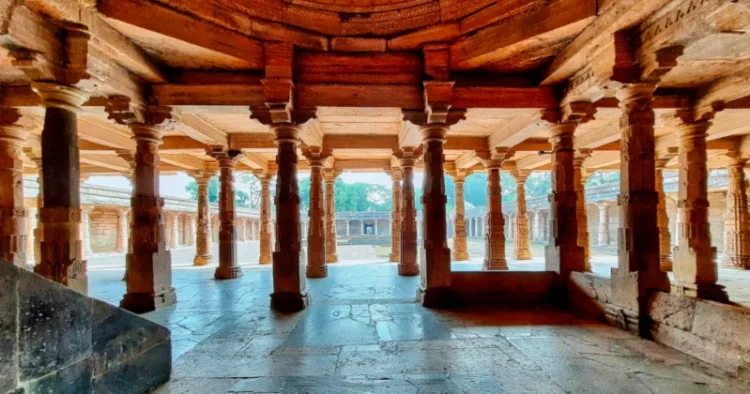The Archaeological Survey of India (ASI) has concluded a 97-day survey at Bhojshala in Dhar, Madhya Pradesh, unearthing a treasure trove of over 1700 artefacts. These discoveries, spanning statues, structures, pillars, walls, and murals, are believed to date back to the illustrious Paramara period, ranging from the 9th to the 11th century. The findings at Bhojshala have ignited scholarly and public interest, suggesting a historical narrative predating the Paramara dynasty, potentially linking to ancient civilisations like the Mohenjodaro culture.
Detailed Findings of ASI at Bhojshala
Throughout the extensive survey, ASI archaeologists have meticulously unearthed artefacts that provide glimpses into the rich historical tapestry of Bhojshala:
Brick Wall Discovery: One of the most significant finds at Bhojshala includes a 27-foot-long brick wall near the sanctum sanctorum. This construction method, unusual for the Paramara period and known for stone architecture, hints at earlier antiquity and possibly traces back to the era of the Mohenjodaro civilisation. The discovery challenges previous assumptions about the site’s age and significance.
Cultural and Religious Diversity: The excavation at Bhojshala has revealed a fascinating blend of cultural and religious artefacts. Inscriptions bearing Quranic verses and statues associated with Jainism were found near the Kamal Maula Dargah, juxtaposing different religious influences at the site. Murals depicting warriors preparing for battle further enrich the historical narrative, reflecting the vibrant cultural exchanges of ancient India.
Specific Area Discoveries
Sanctum Sanctorum and Surroundings: Excavations around the sanctum sanctorum at Bhojshala uncovered remnants of ancient walls and structures, providing insights into the architectural style and religious practices of the Paramara period.
Room Underneath Stairs: A significant cache of artefacts was discovered, including statues depicting Hindu deities such as Vagdevi, Saraswati, Hanuman, and Ganesh. The discovery also included sacred objects like conch shells and chakras, indicative of religious rituals performed at the site.
Northeastern and Western Parts: Statues of Krishna, Vasuki Naga, and Shiva were unearthed alongside numerous pillars and carved remnants of walls. These findings at Bhojshala highlight the site’s religious significance and role as a centre of worship and cultural exchange during ancient times.
Yagyashala Area: Stones engraved with Sanatani symbols were identified, underscoring the religious and spiritual practices prevalent in the region during the Paramara era.
Dargah Area: The excavation revealed an underground Akal Kuiyan, an architectural feature with historical and religious significance in the local context.
Pillars and Inscriptions: Chemical treatment on pillars exposed carvings depicting scenes from Hindu mythology, including Sita-Ram and inscriptions with religious chants like “Om Namah Shivaya.”
On the 97th day of excavation, the ASI team continued to make significant discoveries. For further analysis, three shaped stones were found and carefully preserved in the northeastern region. Additionally, eight remains were unearthed, including figures resembling goddesses and a statue resembling the Narasimha avatar was found at Bhojshala. These artefacts are undergoing a detailed examination to decipher their historical and cultural significance.
The ASI’s findings at Bhojshala have sparked considerable public interest and political discourse. With a report scheduled to be submitted to the court on July 2 and a subsequent hearing on July 4, stakeholders eagerly anticipate the conclusions drawn from these archaeological excavations. The discoveries will inform discussions on heritage preservation, cultural identity, and historical narratives in Madhya Pradesh and beyond.
As ASI prepares to present its detailed report to the court, the discoveries will deepen our understanding of the Paramara era and earlier civilisations that have shaped the region’s identity. These artefacts enrich scholarly research and underscore the importance of preserving cultural heritage for future generations.



















Comments